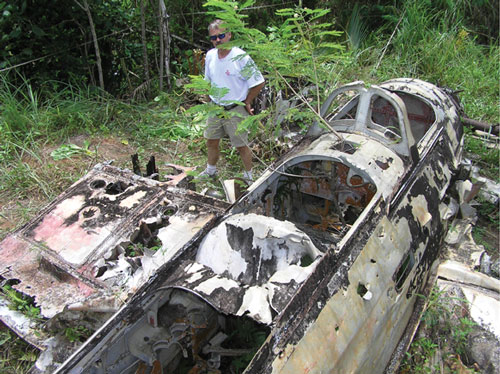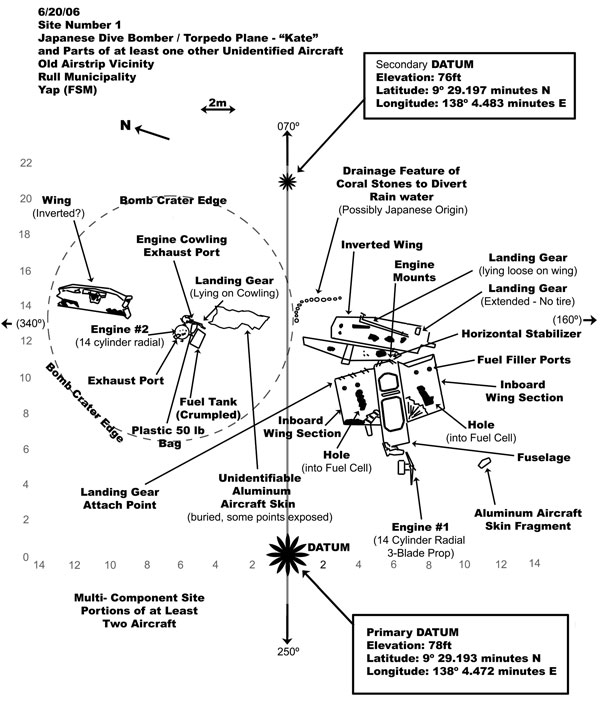 |
at the Old Colonia Airport, Yap State
Federated States of Micronesia
 |
| Plate 2: Site #1; John Clauss. |
This site, located in the dispersal area near the west end of the runway (latitude 9° 29.193′ N, longitude 138o 04.472′ E), represents the bomb-blasted remains of a Nakajima NM5 “Kate” torpedo bomber, together with at least the engine and a wing from another single-engine airplane. Covering an area of about 600 square meters, much of the wreckage lies within a bomb crater some 14 meters in diameter, while the more intact portions of the aircraft lie just to the southeast of the crater. The center section of the Kate’s fuselage and inboard parts of both wings are intact; other large wing pieces, landing gear, and engine parts are closely associated. One engine lies at one end of the fuselage but is not attached to it, while another is in the nearby bomb crater, the latter associated with wing parts, landing gear, a fuel tank and other fragments. It is not entirely clear which engine belongs to the Kate and which to the other aircraft. One engine (presumably the one now lying in line with the fuselage) is reported to have been removed in the 1980s by Japanese collectors (possibly with all or part of the fuselage) and then returned.
Some parts of the engine in the crater (blower and accessory case, rocker covers, cylinder heads) appear to have been unbolted and removed, or broken in the process of removal. The engine has lost its propeller but retains the propeller hub. The engine at the end of the fuselage is corroded, but not too seriously, and retains a propeller and partial exhaust system.
The fuselage skins are relatively lightly corroded, but the paint has been faded due to continuing ultraviolet and visible light exposure. Corrosion is high in areas close to or in contact with the ground. Spar caps show complete exfoliation. All removable components (controls, instruments, placards, etc.) are missing.The unidentified airplane’s right wing is lying upside down on ground with its landing gear straight up. This gear appears to be too long for the plane to have been a Zero, and the flaps and internal structure of the wing appear inconsistent with a Zero’s. The wing is badly corroded and partially crushed.
A detached tail section, which matches published specifications for the Kate, exhibits shrapnel damage and is highly corroded, probably resulting at least in part from the fact that it lies flat on the ground, where it is exposed to a good deal of moisture.

Site Plan.
Site 1 |
 |
Copyright 2021 by TIGHAR, a non-profit foundation. No portion of the TIGHAR Website may be reproduced by xerographic, photographic, digital or any other means for any purpose. No portion of the TIGHAR Website may be stored in a retrieval system, copied, transmitted or transferred in any form or by any means, whether electronic, mechanical, digital, photographic, magnetic or otherwise, for any purpose without the express, written permission of TIGHAR. All rights reserved. Contact us at: info@tighar.org • Phone: 610.467.1937 • JOIN NOW |